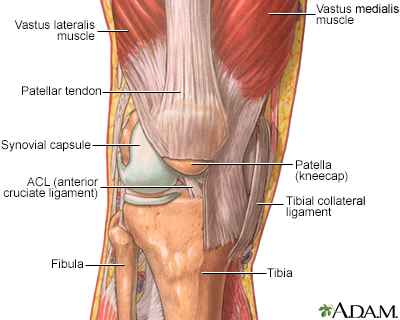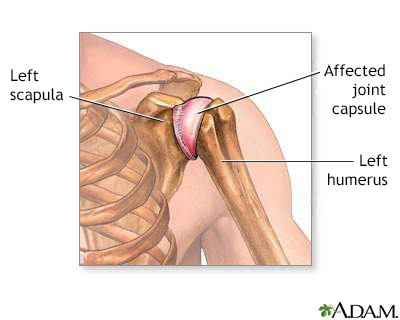Viral arthritis
Infectious arthritis - viral
Viral arthritis is swelling and irritation (inflammation) of a joint caused by a viral infection.

Joints, particularly hinge joints like the elbow and the knee, are complex structures made up of bone, muscles, synovium, cartilage, and ligaments that are designed to bear weight and move the body through space. The knee consists of the femur (thigh bone) above, and the tibia (shin bone) and fibula below. The kneecap (patella) glides through a shallow groove on the front part of the lower thigh bone. Ligaments and tendons connect the three bones of the knee, which are contained in the joint capsule (synovium) and are cushioned by cartilage.

An inflammation of the shoulder joint can cause pain and restricted joint movement.
Causes
Arthritis may be a symptom of many virus-related illnesses. It usually disappears on its own without any lasting effects.
It may occur with infection by:
- Enterovirus
- Dengue virus
- Hepatitis B
- Hepatitis C
- Human immunodeficiency virus (HIV)
- Human parvovirus
- Mumps
- Rubella
- Alphaviruses, including chikungunya
- Cytomegalovirus
- Zika virus
- Adenovirus
- Epstein-Barr virus
- Ebola virus
Note: This list is not all inclusive.
It may also occur after immunization with the rubella vaccine, which is typically given to children.
While many people are infected with these viruses or receive the rubella vaccine, only a few people develop arthritis. No risk factors are known.
Symptoms
The main symptoms are joint pain and swelling of one or more joints.
Exams and Tests
A physical examination shows joint inflammation. A blood test for viruses may be performed. In some cases, a small amount of fluid may be removed from the affected joint to determine the cause of the inflammation.
Treatment
Your health care provider may prescribe pain medicines to relieve discomfort. You may also be prescribed anti-inflammatory medicines.
If joint inflammation is severe, aspiration of fluid from the affected joint may relieve pain.
Outlook (Prognosis)
The outcome is usually good. Most viral arthritis disappears within several days or weeks when the virus-related disease goes away.
When to Contact a Medical Professional
Contact your provider for an appointment if arthritis symptoms last longer than a few weeks.
References
Gasque P, Guillot X. Viral arthritis. In: Firestein GS, Budd RC, Gabriel SE, Koretzky GA, McInnes IB, O'Dell JR, eds. Firestein and Kelley's Textbook of Rheumatology. 11th ed. Philadelphia, PA: Elsevier; 2021:chap 121.
Ohl CA. Infectious arthritis of native joints. In: Bennett JE, Dolin R, Blaser MJ, eds. Mandell, Douglas, and Bennett's Principles and Practice of Infectious Diseases. 9th ed. Philadelphia, PA: Elsevier; 2020:chap 103.
Version Info
Last reviewed on: 12/31/2023
Reviewed by: Jatin M. Vyas, MD, PhD, Associate Professor in Medicine, Harvard Medical School; Associate in Medicine, Division of Infectious Disease, Department of Medicine, Massachusetts General Hospital, Boston, MA. Also reviewed by David C. Dugdale, MD, Medical Director, Brenda Conaway, Editorial Director, and the A.D.A.M. Editorial team.
